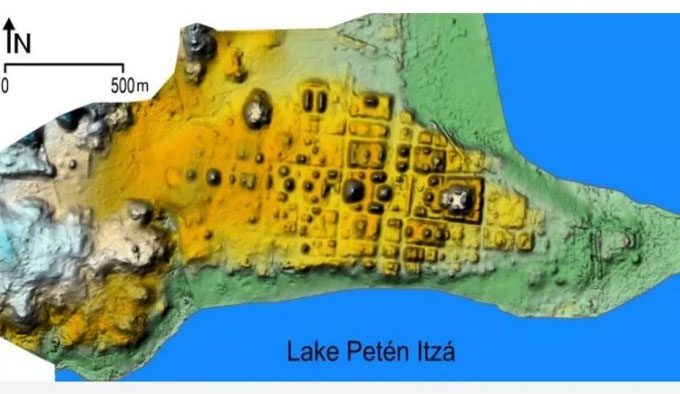The city of Nixtun-Ch’ich’ has the capacity to host thousands of ancient Maya residents and resembles a crocodile when viewed from above.
Nixtun-Ch’ich’ dates back over 2,500 years and features a unique checkerboard layout. Located on the southwestern edge of Lake Petén Itzá, in what is now the Petén region of Guatemala, Nixtun-Ch’ich’ was the largest and most powerful settlement in the area during the Preclassic period, a time that marked the transition from hunter-gatherer societies to more complex agricultural societies, as reported by Newsweek on November 13.

Map of Nixtun-Ch’ich’ city viewed from above. (Photo: Timothy Pugh)
The most notable feature of the city is its checkerboard urban layout, constructed around 800-500 BCE or possibly even earlier. The checkerboard sections are concentrated along a 3.2 km road lined with 21 buildings oriented southeast, which may align directly with the sunrise on certain days of the year, according to research published in the journal Frontiers in Political Science. Prudence Rice, an anthropology professor at Southern Illinois University and a member of the research team, suggests that the unique design of Nixtun-Ch’ich’ resembles the back of a crocodile.
Crocodiles held significant importance for the Maya and symbolized various concepts, according to Timothy Pugh, an anthropology professor at Queens College, City University of New York, and Rice’s collaborator at Nixtun-Ch’ich’. In addition to being associated with seasonal renewal, crocodiles also symbolize fertility and regeneration. In nature, crocodiles inhabit both terrestrial and aquatic environments, thus representing duality in the cosmology of ancient Mesoamerica.
According to Rice, the design of Nixtun-Ch’ich’ carries profound spiritual significance, mimicking the mythical crocodile and illustrating the role of idealized power in the development of complex societies. Although the area today is located on a peninsula jutting into Lake Petén Itzá and is overgrown with weeds, research conducted over the past few decades by Pugh and Rice has revealed the ancient city’s topography. Maps created using GPS data show the structure’s layout within the city, featuring a network of straight lines. The site resembles a crocodile with a symmetrical shape and neighborhoods that appear like the scaly back of the creature.
Pugh states that Nixtun-Ch’ich’ is the only known archaeological site from the Maya period constructed to resemble a crocodile. However, the research team emphasizes the need for further evidence, such as artifacts or artworks depicting the city alongside a crocodile, to strengthen the hypothesis that this design was intentional in the minds of the ancient Maya.


















































